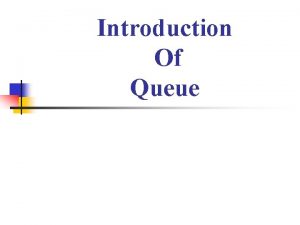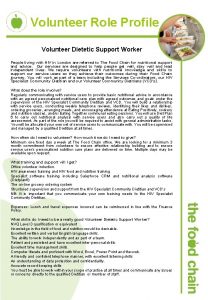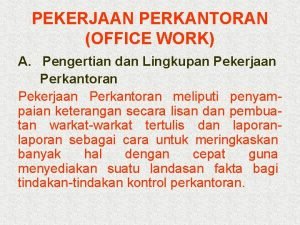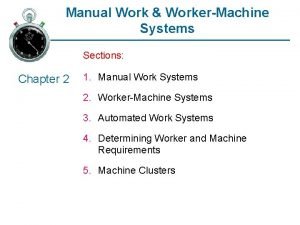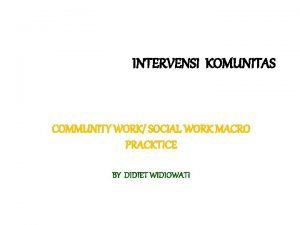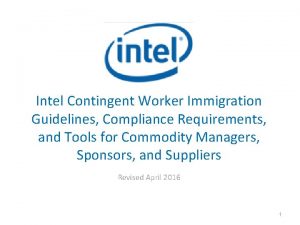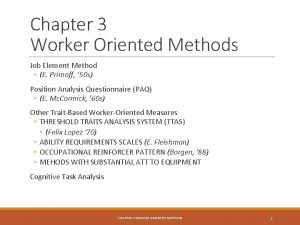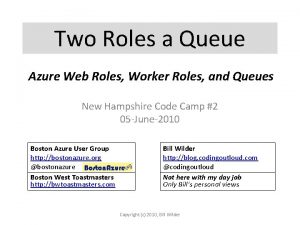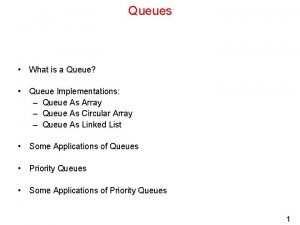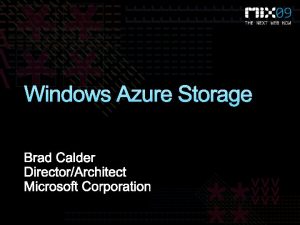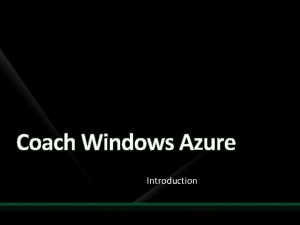Two Roles a Queue Azure Web Roles Worker

Two Roles a Queue Azure Web Roles, Worker Roles, and Queues Boston Azure User Group http: //bostonazure. org @bostonazure Boston West Toastmasters http: //bwtoastmasters. com Bill Wilder http: //blog. codingoutloud. com @codingoutloud Not here with my day job Only Bill’s personal views Copyright (c) 2010, Bill Wilder

Goal: Build software systems where… • • Time-to-market is short Effort focuses on business functionality Development is highly productive Cost structure is a good fit Downtime is not necessary Scale is efficient Modification is straight-forward Infrastructure is not a limiting factor

Agenda for Roles & Queues • • • What are Roles and Queues? What tools are needed? Why are Roles important? Why are Queues important? Why does Rn Qn Rn matter? How do I Build, Debug, and Deploy?

Two Concepts 1. Roles –Web Roles –Worker Roles 2. Queues

Web Roles are a lot like Web Pages ASP. NET Page Build using ASP. NET, MVC Runs in IIS 7 Visible to Internet Good to handle interactive users Good for hosting Web API (WCF) Language Agnostic Web Role Worker Role

Queue

Key Pattern: Roles + Queues Web Role (IIS) Worker Role Queues Blobs Tables

Canonical Example: Thumbnails Web Role (IIS) Worker Role Queues Blobs Tables

Key Pattern: Roles + Queues Web Role (IIS) Worker Role Queues

Pre-Azure Development Tool Stack • Visual Studio • C#, VB. NET, F#, … • . NET Runtime

Azure Development Tool Stack • • Visual Studio C#, VB. NET, F#, …. NET Runtime Dev Fabric, Azure Toolkit , Azure SDK • Plus… • Could be non-Visual Studio, non-. NET-based • REST access to all Azure Services

Pre-Azure Server Stack • • • . NET Runtime (3. 5) Windows Server 2008, IIS 7 Windows Communication Foundation (WCF) SQL Server MSMQ ASP. NET, ASP. NET MVC

Azure Server Stack • • • . NET Runtime (3. 5) Windows Server 2008, IIS 7 Windows Communication Foundation (WCF) SQL Server SQL Azure SQL Server Azure Blobs null Azure Table Storage MSMQ Azure Queues ASP. NET, ASP. NET MVC Azure Web Role null Worker Roles

Default. aspx. cs • public partial class _Default : System. Web. UI. Page • { • protected void Page_Load(…) • { • if (Page. Is. Post. Back) • { • throw new Exception( • "goodbye cloud"); • }

Global. asax. cs • static int x = 0; • protected void Application_Error(object sender, Event. Args e) • { Exception ex = Server. Get. Last. Error(); • if (ex. Get. Type() == typeof(Http. Exception)) { … } • Response. Write(ex. Message); • Server. Clear. Error(); • • } if (x % 3 == 0) Response. Redirect("default. aspx"); • http: //crashtestdummy. cloudapp. net/

Pre-Azure Operational Concerns • • • Buying hardware Cap. Ex Provisioning Servers Configuring Servers and Services Patching the Operating System (Human) Ops Resource Intensive

Azure Operational Concerns • • • Buying hardware null Cap. Ex Variable cost / Utility pricing Provisioning Servers null Configuring Servers and Services null Patching the Operating System null (Human) Ops Resource Intensive null + Communication paths reduced

Key Pattern: Roles + Queues Web Role (IIS) Worker Role Queues

Roles and Queue • Allow loosely coupled workflow between roles • Messages not processed strictly FIFO • Queue length (and trend) is key metric for tuning Role deployment numbers

n Roles Key Pattern: + Rn Qn Rn n Queues Worker Role Type 1 Web Role (IIS) Role (IIS) Queues Worker Role Type 2

Azure Queues by the Numbers 100% = Reliability of message delivery 30 seconds = default “invisibility window” 8 KB = max size of a queued item 7 days = max length an item can stay on queue 500 = approx number of transactions a queue can handle per second • N = number of queues you can have (N >> 1) • • •

Out is the new Up • Scaling Out has hard limits at CPU, Memory – Architecturally more limiting

Rn Qn Rn requires Idempotent • If we do a task twice, end result same as if we did it once

Rn Qn Rn enables Responsive • Response to interactive users is as fast as a work request can be persisted • Time consuming work done off-line • Same total resource consumption, better subjective experience

Rn Qn Rn enables Scalable • Loosely coupled, concern-independent scaling • Blocking is Bane of Scalability – Decoupled front/back ends insulate from other system issues if… – Twitter down – Email server unreachable – Order processing partner doing maintenance – Internet connectivity interruption

Rn Qn Rn enables Resilient • “Plan for failure” • There will be role restarts • Bake in handling of restarts – Not an exception! – Restarts are routine, system “just keeps working” • Change the “service” topology by adding or removing role instances… – Without service interruption

Common Problems • Hard to upgrade without downtime • Wasteful to provision for peak load • Time consuming to add more dev or test environments

What’s Going Down? Typical Site Operating System Upgrade Application Update / Deploy Change Topology Hardware Failure Software Bug / Crash / Failure Security Patch An Azure Role Azure Site

Scale Out easier to Spread Out • Scale out systems better suited for geographic distribution – More efficient and flexible because more granular – Hard for a mega-machine to be in more than one place – Failure need not be binary

Azure’s Abstraction • Code that knows about failover, other computers, environments, … – Does. Not. Exist. in your application code • Azure’s App. Fabric handles • So Roles support many properties – Azure allows for a clean implementation or Roles

These capabilities are not all new… right?

Not new, but…

Accessible to us mere mortals Less complex, more cost-effective, competitive pressure: everyone’s doing it

Advanced Queue Topics • • • Code for retries – Plan to fail Poison Messages Exception handling Fully utilize Roles – complexity trade-off Async notification of new Queue items

Advanced Worker Role Topics • Full utilization of a WR instance is more work – Message stays in queue for 7 days – You pay by instance, not resource use within • Tactics… – Read >1 message from queue at a time – Have multiple message types handled in one worker role – Build multi-threaded Worker Role • Build simple “scale with the config file” systems – Is time-to-market more imp than deployment / run costs? – Trade off scale efficiency, maintainability, time-to-market • Business Decisions!

Silver Bullet? • Question: Does Azure make my application scale automatically?

Closing thought • Do we really need “the cloud” for all these great properties? • Does (cloud == scalability + operational simplicity + cost savings + fast time-to-market)?

“These go to eleven” –Nigel Tufnel The cloud is an amplifier – emerging as best system of software services + patterns + tools + ecosystem for tomorrow’s systems
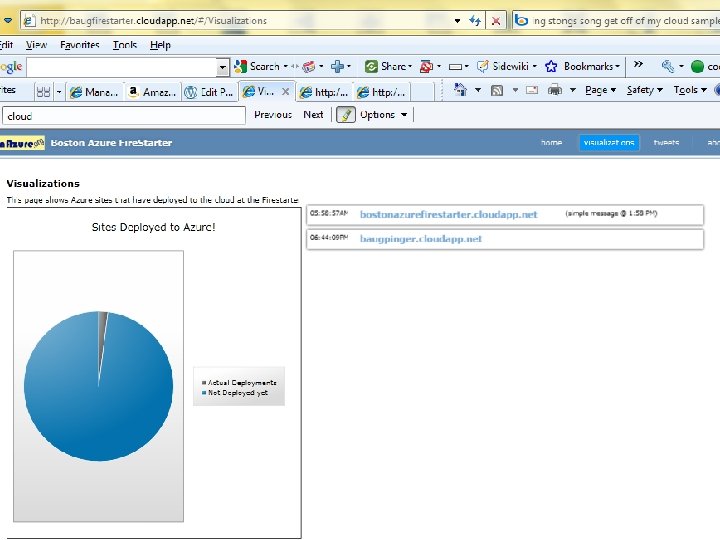
Visualizer

• http: //baugfirestarter. cloudapp. net/ • http: //bostonazuresample. cloudapp. net/ • Narrative for Lab 1: • http: //hmbl. me/1 H 4 ZVZ • (about breaks…)

Lab Time

Lab Time
- Slides: 42


